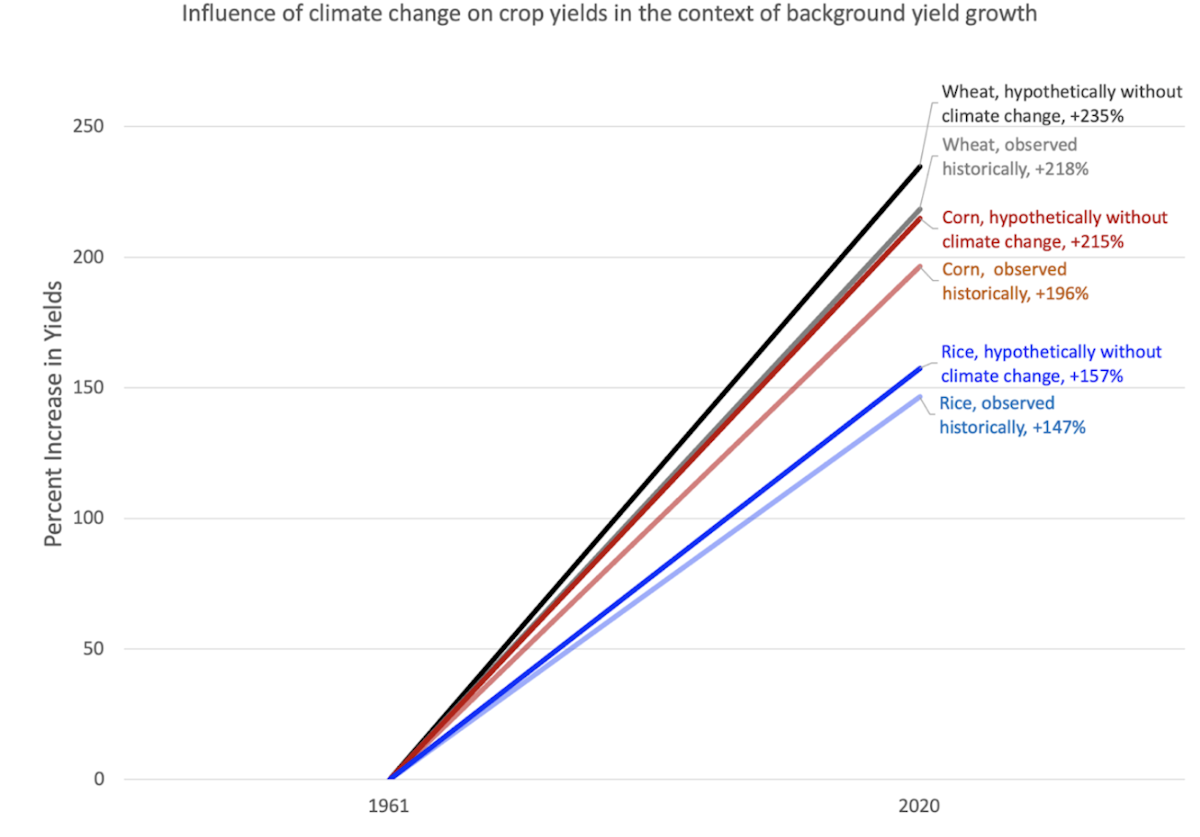Will Climate Change Starve Us All?
No, But Bad Science Communication and Fear Mongering Might
-
-
Share
-
Share via Twitter -
Share via Facebook -
Share via Email
-
In 2014, Scientific American published a short but ominous article titled “Only 60 Years Left of Farming if Soil Degradation Continues.” Similar claims popped up in the Guardian in 2019 and in the BBC in 2024.
The BBC article, which proclaims that the world’s poorest areas already “have zero harvests left,” alludes to comparisons with “Mad Max”: apocalyptic wastelands with humans fighting over the last remaining morsels of a long-gone cornucopia.
But the claim that earth has a small number of agricultural harvests is unfounded. In 2021, the data scientist Hannah Ritchie busted the myth for Our World in Data. Not only could Ritchie find no existing scientific citation for the claim, she found that such a claim could not possibly be defended. It is true that most soils around the world face some level of degradation. But the level and factor varies by region. Further, a majority of soils, even those managed with intensive agricultural practices—the main culprit of soil degradation, according to those predicting agricultural apocalypse—have many hundreds, if not thousands of years of harvests left.
The claims about soil degradation would not be the first time the media has bombarded the general public with excessively bleak depictions of our agricultural future with little evidence. Indeed, the general public is subjected to outright fear mongering when it comes to the future of food. Beyond soil degradation, climate change and its supposed impacts on agricultural yields are another cause for food panic.
For journalists heralding the “end of food” as we know it, the main sources are typically either activist researchers or long-standing critics of industrial food production with a vested interest in its alternatives—whether regenerative or organic agriculture. Whether it’s the BBC citing the Rodale Institute about declining nutrients in produce, or the Guardian advocating for regenerative farming practices by overstating soil degradation, their coverage of modern food systems sells the narrative that our food systems are crumbling and the only solution is embracing anti-technological farming practices.
The problem is that this narrative isn’t just wrong; it is dangerous. The practices these food systems critique elevate will have worse impacts on climate, global food security, and the environment writ large.
Climate Change Hasn’t Been and Won’t be the Main Driver of Agricultural Productivity
Although climate change may reduce agricultural productivity compared to a world without climate change, there is no reason to believe that its impact can’t be completely negated through technological progress.
Hundreds of studies encompassing a range of data sets, methods, models, and variables have been published on the impact of climate change on agriculture.
One major global study, that analyzed crop yields from 1974 to 2008, found that while responses in yields to climate change varied widely by location and crop, there was a global net 1% decrease in consumable food calories of 10 major crops compared to a hypothetical world without climate change. Another recent study indicated that a range of potential warming and enhanced CO2 levels will actually increase global wheat, rice, and perhaps soybean yields and decrease maize yields. Most studies, however, tend to find that, on a global level, climate and CO2 changes are detrimental to yields.
Even so, climate change’s detrimental effects pale in comparison to the overall productivity growth caused by technological and practical advances in agricultural production.

As I wrote two weeks ago with Vijaya Ramachandran, the past half-century has seen about 1 degree Celsius in global warming. And yet, global agricultural output has increased almost four-fold over the same period. This increase in agricultural output is responsible for the prevention of g more than 3 billion hectares of land being converted to agricultural land—about a quarter of the world’s total arable land.
These yield gains saved lives. We’ve seen a steady decline in hunger over the past five decades, despite an uptick in the past few years due to conflict, the COVID-19 pandemic, and, to be sure, extreme weather impacts. For example, the amount of calories produced per person globally has increased by a quarter since 1970, despite the world population more than doubling.
Increased agricultural yields, which came despite a changing climate, were due to technological advances. These include synthetic fertilizers, modern pesticides, fungicides, and herbicides; fossil-powered mechanical equipment; expansive irrigation systems; advanced breeding, including genetic modification; confined animal feeding; and many other technologies, drove the incredible yield growth in both staple and specialty crops, and the massive leaps forward in livestock production. And there is no reason to believe, as BTI’s Patrick Brown, Emma Kovak, and I argued in 2023, that technological and socioeconomic factors will suddenly stop impacting agricultural yields.
Advancing Agriculture: A Multi-pronged Approach
Combining public and private research and development, the agricultural innovations of the 20th century have saved billions of lives by reducing rates of hunger and malnutrition around the world. Altogether, these technologies could be summed up as the “chemical revolution.” Advances in chemistry enabled farmers to maintain soil nutrients, protect crops, and grow massive amounts of staple crops to feed both a growing population of humans and of livestock.
In developed economies, these advances have been adopted at scale, enabling mass urbanization and the growth of middle classes. In less developed economies, agricultural improvement has been uneven and sporadic.
Uneven agricultural development means there are multiple pathways for the kinds of technological advancements that can drastically increase agricultural yields, and in the long run, productivity.
In developed economies, where the “chemical revolution” is mostly complete, increasing agricultural productivity will mean more and more innovation. In grandiose terms, a new revolution in agriculture will be needed. But, unlike what the advocates of organic, regenerative, or other forms of labor-intensive agriculture offer, this revolution will likely be relatively top-down and beneficial to the massive farms that characterize modern agriculture.
Instead of a chemical or even mechanical revolution, the coming age of agriculture will be biological. Advances in crop and animal breeding, combined with new genetic technologies, and advances in the understanding of biological relationships in soil, crop, and livestock production systems will likely be the avenue by which modern agriculture continues being modern.
But these advances will require time and continued investment in both public and private research and development. Improvement in the practical application of existing technologies will continue to enable agricultural productivity growth in the short term, but long-term yield growth in already modernized agricultural systems will require technological breakthroughs like the ones that enabled the “chemical revolution.”
Meanwhile, in regions and economies that have not yet benefited from the many agricultural technological improvements of the 20th century, increasing agricultural productivity can be done at a massive scale, simply by supporting the adoption of the same technologies that enabled 20th-century yield growth in developed economies. This technological adoption is undoubtedly the largest lever on agricultural yields globally. Yield gaps between developed and developing economies are stark. Closing those gaps can more than offset even the most severe impacts of anthropogenic global warming.
Growing Yields or Sacrificing Them
There is a deep irony to how critics of the world’s food systems use the supposed impacts of climate change on agricultural yields to advocate for their preferred alternatives—alternatives that are proven to have negative impacts on crop and livestock yields.
Organic agriculture, on average, is about a fifth less productive than conventional agricultural production. The practices most closely associated with regenerative agriculture—cover crops, no-till, multi-paddock grazing—often have yield penalties. That is, if advocates like Volkert Engelsman of International Federation of Organic Agriculture Movements, who was cited by Scientific American, got their way, farms would sacrifice far more in terms of yields than if climate change were to ravage our food systems. This is true, too, for the advocates of organic farming cited in the Guardian—Peter Melchett of the UK’s Soil Association—or the regenerative advocate cited by the BBC—Praveena Sridhar of Save Soil.
In theory, a global switch to organic or regenerative agriculture by 2050 would have a worse impact on food security, the farm economy, and political stability than climate change, especially when modelers account for technological change. For example, a 2022 UN Future of Food and Agriculture analysis that mapped climate impacts on agriculture as one of the 18 main factors for agricultural productivity estimated that global agricultural production would increase by 50% by 2050 even with a changing climate. The close to 20% reduction in yields that would result from a full blown transition to organic agriculture would be significantly more catastrophic than almost any imagined climate future.
A global switch to organic or regenerative agriculture, by the same logic, would also be far worse for climate mitigation than continuing to rely on high-efficiency conventional agriculture. Reducing agricultural yields would require an expansion of crop and pasture lands, resulting in significant carbon emissions in the short-term. In the long-term, emissions from wholly organic food systems—that would rely on animal agriculture to provide manure for fertilizer, and would still spray potentially harmful “organic” pesticides—would match, if not exceed, conventional systems, but would do so on a far larger land footprint, limiting the amount of forests, marshland, grassland, or other wildland that could serve as a global carbon sink.
In practice, we already have examples of what might happen if the organic advocates won the agricultural transformation they dream of. In 2022, Sri Lanka decided to ban the sale and use of synthetic fertilizers at the behest of advocates such as Vandana Shiva. The ensuing months saw failing crop yields, skyrocketing food prices, and ultimately, a public coup that forced out President Gotabaya Rajapaksa.
To be sure, climate change will likely impact our food systems. Some prices will go up, some will go down. But, technological breakthroughs and the adoption of existing technologies will also impact our food systems for the better. Rejecting industrial agriculture would be a grave mistake.

